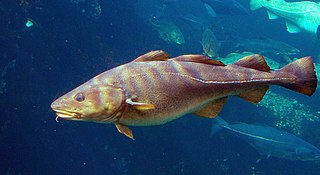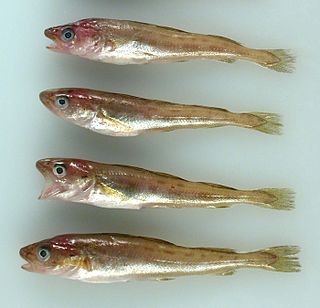
Cod is the common name for the demersal fish genus Gadus, belonging to the family Gadidae. Cod is also used as part of the common name for a number of other fish species, and one species that belongs to genus Gadus is commonly not called cod.

The Atlantic cod is a fish of the family Gadidae, widely consumed by humans. It is also commercially known as cod or codling. Dry cod may be prepared as unsalted stockfish, and as cured salt cod or clipfish.

The narwhal, also known as the narwhale, is a species of toothed whale. It is a member of the Monodontidae family, and the only species in the genus Monodon. Adults are typically 3.95 to 5.5 m in length and 800 to 1,600 kg in weight. The most prominent feature of the species is an adult male's long single tusk that can be up to 3 m (9.8 ft). Instead of having a dorsal fin, narwhals possess a shallower dorsal ridge. They are gregarious animals, and may associate in groups of up to 20 members. Carl Linnaeus scientifically described the species in 1758 in his work Systema Naturae.

The haddock is a saltwater ray-finned fish from the family Gadidae, the true cods. It is the only species in the monotypic genus Melanogrammus. It is found in the North Atlantic Ocean and associated seas, where it is an important species for fisheries, especially in northern Europe, where it is marketed fresh, frozen and smoked; smoked varieties include the Finnan haddie and the Arbroath smokie.

Boreogadus saida, known as the polar cod or as the Arctic cod, is a fish of the cod family Gadidae, related to the true cod. Another fish species for which both the common names Arctic cod and polar cod are used is Arctogadus glacialis.

The Greenland cod, commonly known also as ogac, is a species of ray-finned fish in the cod family, Gadidae. Genetic analysis has shown that it may be the same species as the Pacific cod. It is a bottom-dwelling fish and is found on the continental shelf in the Arctic Ocean and northwestern Atlantic Ocean, its range extending from Alaska to West Greenland, then southwards along the Canadian coast to the Gulf of St. Lawrence and Cape Breton Island. It is a commercially harvested food fish, but landings have been greatly reduced in recent years.

Arctogadus glacialis, known also with ambiguous common names Arctic cod and polar cod, is an Arctic species of fish in the cod family Gadidae, related to the true cod. Arctogadus glacialis is found in icy water. They grow to about 30 cm long, and are favorite food of narwhals and other arctic whales.

The saffron cod(Eleginus gracilis) is a commercially harvested fish closely related to true cods. It is dark grey-green to brown, with spots on its sides and pale towards the belly. It may grow to 55 cm and weigh up to 1.3 kg.

The East Siberian Sea is a marginal sea in the Arctic Ocean. It is located between the Arctic Cape to the north, the coast of Siberia to the south, the New Siberian Islands to the west and Cape Billings, close to Chukotka, and Wrangel Island to the east. This sea borders on the Laptev Sea to the west and the Chukchi Sea to the east.

The harp seal, also known as Saddleback Seal or Greenland Seal, is a species of earless seal, or true seal, native to the northernmost Atlantic Ocean and Arctic Ocean. Originally in the genus Phoca with a number of other species, it was reclassified into the monotypic genus Pagophilus in 1844. In Greek, its scientific name translates to "ice-lover from Greenland," and its taxonomic synonym, Phoca groenlandica translates to "Greenlandic seal." This is the only species in the genus Pagophilus.

Thymallus or graylings is a genus of freshwater salmonid ray-finned fish and the only genus within the subfamily Thymallinae. Although all Thymallus species can be generically called graylings, without specific qualification the term "grayling" typically refers to the type species Thymallus thymallus, the European grayling.
Siberian taimen, also known as the common taimen, Siberian giant trout or Siberian salmon, is a species of salmon-like ray-finned fish from the genus Hucho in the family Salmonidae. These fish are found in rivers in Siberia and adjacent regions, and are harvested throughout the year.

The ciscoes are salmonid fish that differ from other members of the genus Coregonus in having upper and lower jaws of approximately equal length and high gill raker counts. These species have been the focus of much study recently, as researchers have sought to determine the relationships among species that appear to have evolved very recently. The term cisco is also specifically used of the North American species Coregonus artedi, also known as lake herring.
The East Siberian grayling(Thymallus pallasii) is a grayling in the salmon family Salmonidae. Males can reach a size of 44 cm (17 in).

The northern wolffish, also known as the blue sea cat or jelly cat, is a species of marine ray-finned fish belonging to the family Anarhichadidae, the wolf fishes. This species is found in the North Atlantic Ocean and Arctic Ocean.

Cod fisheries are fisheries for cod. Cod is the common name for fish of the genus Gadus, belonging to the family Gadidae, and this article is confined to three species that belong to this genus: the Atlantic cod, the Pacific cod and the Greenland cod. Although there is a fourth species of the cod genus Gadus, Alaska pollock, it is commonly not called cod and therefore currently not covered here.
Polarella is a dinoflagellate, and is the only extant genus of the Suessiaceae family. The genus was described in 1999 by Marina Montresor, Gabriele Procaccini, and Diane K. Stoecker, and contains only one species, Polarella glacialis. Polarella inhabits channels within ice formations in both the Arctic and Antarctic polar regions, where it plays an important role as a primary producer. Polarella is a thecate dinoflagellate, wherein the cell has an outer covering of cellulose plates, which are arranged in nine latitudinal series. The general morphology of Polarella is similar to that of a typical dinoflagellate. and Polarella has a zygotic life history, wherein it alternates between a motile vegetative phase and a non-motile spiny cyst. While it is thought that the cysts of Polarella have lost their ability to form fossils, the cyst life cycle stage has acted as link to extinct members of the Suessiaceae family.

The Arctic flounder, also known as the Christmas flounder, eelback flounder and Polar plaice, is a flatfish of the family Pleuronectidae. It is a demersal fish that lives on coastal mud bottoms in salt, brackish and fresh waters at depths of up to 90 metres (300 ft). Its native habitat is the polar waters of the northeastern Atlantic and Arctic oceans, from the White and Barents seas to the coasts of Siberia in Russia and Queen Maud Gulf in Canada, and from the Chuckchi and Bering seas to Bristol Bay in Alaska and the northern Sea of Okhotsk. It can grow up to 35 centimetres (14 in) in length.

Myoxocephalus scorpioides, the Arctic sculpin or northern sculpin, is a species of marine ray-finned fish belonging to the family Cottidae, the typical sculpins. This fish is found in the Arctic Ocean.

The whitespotted grouper, also known as the rankin cod, ocellated rockcod, small-spotted cod, white-spotted reef-cod or whitespotted rockcod, is a species of marine ray-finned fish, a grouper from the subfamily Epinephelinae which is part of the family Serranidae, which also includes the anthias and sea basses. It has an Indo-Pacific distribution. It is closely related to two other species of white spotted groupers in the genus Epinephelus.
















